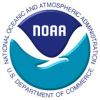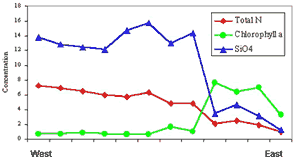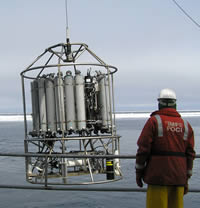
|

|
| Home | Log | the Research | Images and Video | Maps | Data | Links |
| Introduction | Physical Oceanography | Nutrient Chemistry | Phytoplankton | Zooplankton | Acoustics/Fish | Seabirds | Marine Mammals |



Bering Sea Ice Expedition Research Activities - Nutrient Chemistry |
|
|
Nutrients in the ocean are chemicals or compounds necessary for the nutrition and growth of phytoplankton. Just like on land, plants require nitrogen and phosphorus to grow. In addition to nitrogen and phosphorus, silica is a nutrient required by a type of phytoplankton called diatoms. In the photic zone (sunlit waters near the ocean surface), concentrations of dissolved nutrients decline as phytoplankton grow. Nutrients are returned to the water as plants and animals die and decay. The reserve of nutrients in deep water is constantly replenished by dead organisms and fecal pellets that sink as marine snow decay in the deep sea. To complete the cycle, nutrients are brought to the surface waters by upwelling, turbulence and vertical mixing. [see external web info: diatoms, marine snow, upwelling]
Concentrations of ocean nutrients vary with time (year or season) and space (where they are in the ocean). By knowing when and where nutrient concentrations occur in ocean waters, we can predict phytoplankton blooms. The graph (left) depicts concentrations of nitrogen (N), silica (SiO4), and phytoplankton (as inferred from chlorophyll) in late June 1997 from a survey across Cook Inlet, Alaska. Note that decreases in nitrogen and silica concentrations in the eastern portion of the survey are inversely correlated with phytoplankton abundance. While a drop in nitrogen concentrations is typical of use by any phytoplankton, the high utilization of silica suggests that diatoms were common at this time.
In early spring, the water column on the Bering Sea shelf is well mixed, and nutrients are plentiful. As the season progresses, heat from the sun and fresh water from ice-melt can result in a layer of less dense water at the surface. Because phytoplankton in this surface layer are exposed to more light, they begin to bloom and quickly use up the nutrients. As the nutrients in the surface layer decrease, the phytoplankton cannot reproduce as quickly (due to nutrient limitation), and the bloom ends. After the onset of nutrient limitation, storms can mix the water column, bringing deep nutrients into the surface layer resulting in smaller secondary blooms. Sea ice may also be a source of nutrients to the ecosystem. |
|
| Privacy | Disclaimer | Accessibility | Contact Information |


